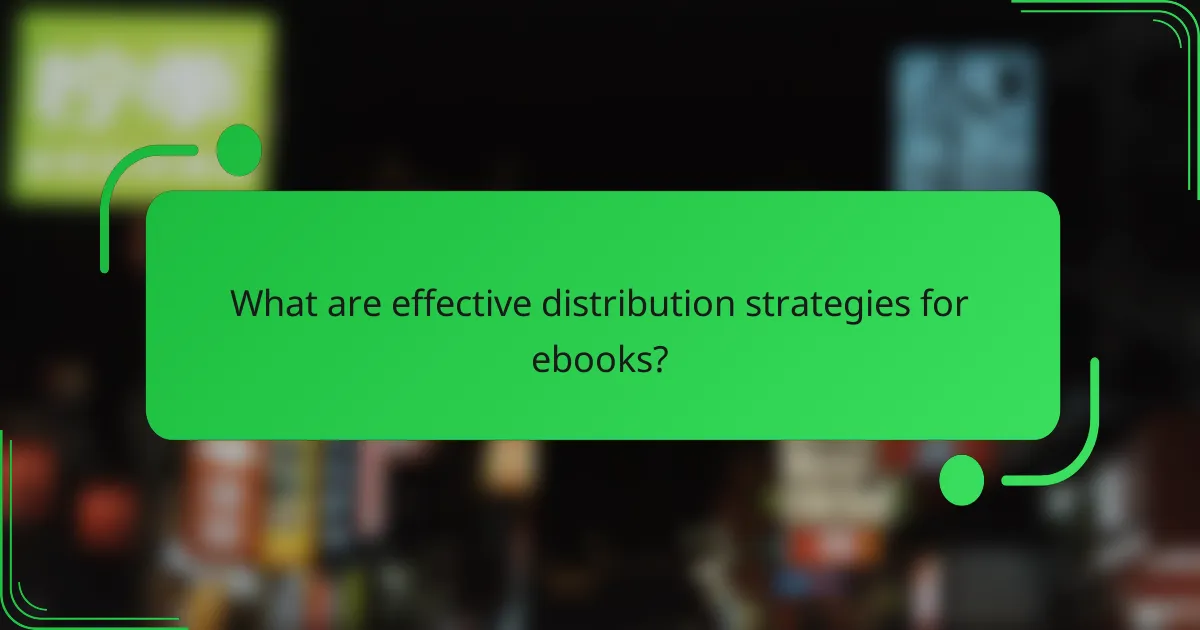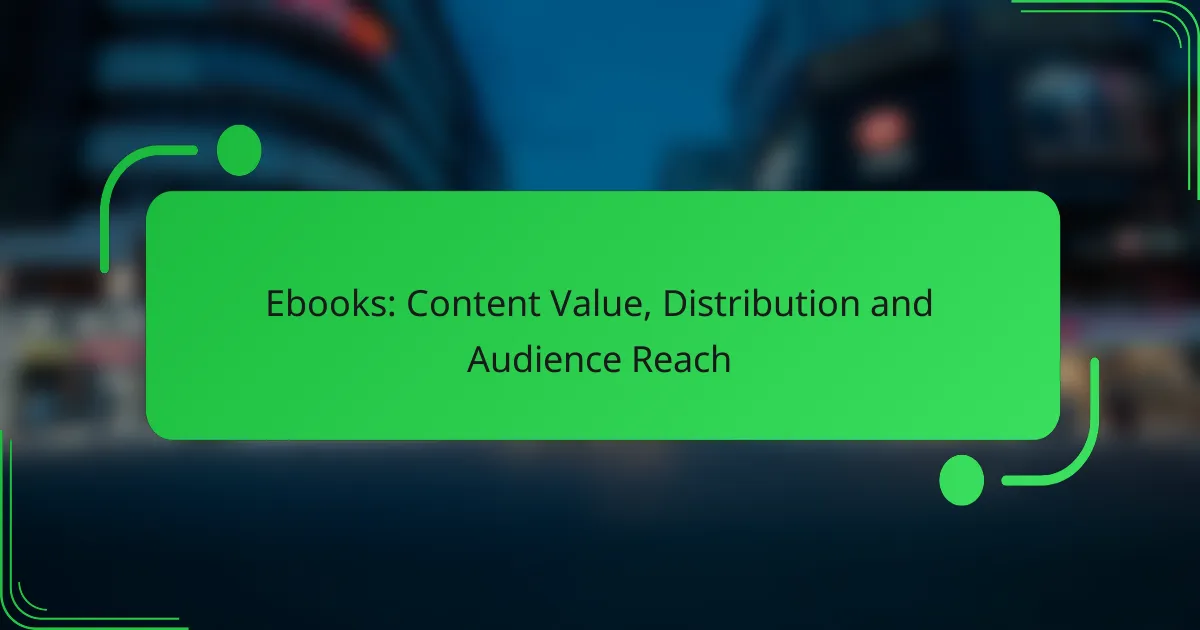Ebooks are a valuable asset in marketing, offering in-depth content that not only engages readers but also positions a brand as an authority in its field. By implementing effective distribution strategies across multiple channels, authors can maximize their reach and enhance visibility, ultimately fostering audience engagement and driving conversions.

How can ebooks enhance content value in marketing?
Ebooks can significantly enhance content value in marketing by providing in-depth information that engages readers and establishes a brand’s expertise. They serve as a powerful tool to attract and retain an audience, ultimately driving conversions and customer loyalty.
Increased audience engagement
Ebooks foster increased audience engagement by offering valuable insights that resonate with readers. Unlike shorter content forms, ebooks allow for deeper exploration of topics, which can keep readers interested for longer periods.
To maximize engagement, consider incorporating interactive elements such as quizzes or embedded videos within the ebook. This can enhance the reading experience and encourage sharing among users.
Establishing authority in niche markets
Creating high-quality ebooks helps establish authority in specific niche markets by showcasing expertise and knowledge. When a brand publishes well-researched content, it positions itself as a thought leader, which can attract a loyal following.
To build authority, focus on addressing common pain points within the niche and providing actionable solutions. This not only builds trust but also encourages readers to view the brand as a go-to resource.
Lead generation through valuable content
Ebooks can be effective tools for lead generation by offering valuable content in exchange for contact information. By requiring readers to submit their email addresses or other details to access the ebook, brands can build a targeted email list for future marketing efforts.
To optimize lead generation, ensure that the ebook addresses a specific problem or need that your target audience faces. Promoting the ebook through social media and email campaigns can further enhance visibility and attract potential leads.

What are effective distribution strategies for ebooks?
Effective distribution strategies for ebooks involve utilizing various channels to maximize reach and engagement. By combining email marketing, social media, and partnerships with influencers, authors can significantly enhance their visibility and sales.
Utilizing email marketing campaigns
Email marketing is a direct way to reach potential readers and drive ebook sales. Building a targeted email list allows authors to send personalized messages, updates, and promotions to interested subscribers.
Consider segmenting your audience based on interests or previous purchases to tailor your content. Offering exclusive discounts or free chapters can incentivize subscribers to engage with your ebook.
Leveraging social media platforms
Social media platforms are essential for promoting ebooks and connecting with readers. By sharing engaging content related to your ebook, such as quotes, behind-the-scenes insights, or reader testimonials, you can build a community around your work.
Utilize platforms like Facebook, Instagram, and Twitter to run targeted ads that reach specific demographics. Regularly interacting with followers can also foster loyalty and encourage word-of-mouth promotion.
Partnering with influencers and affiliates
Collaborating with influencers and affiliates can expand your ebook’s reach to new audiences. Influencers can provide authentic endorsements that resonate with their followers, while affiliates can earn commissions for driving sales through their platforms.
Identify influencers within your genre and propose mutually beneficial partnerships. Offering free copies of your ebook for review or promotion can be an effective way to initiate these collaborations.

How can you measure audience reach for ebooks?
Measuring audience reach for ebooks involves tracking various metrics that indicate how many people are accessing and engaging with your content. Key methods include monitoring downloads, analyzing engagement, and collecting feedback to understand your audience better.
Tracking downloads and conversions
Tracking downloads is a fundamental way to gauge audience reach. Use analytics tools to monitor how many times your ebook has been downloaded across different platforms. Additionally, track conversion rates to see how many downloads lead to desired actions, such as signing up for a newsletter or making a purchase.
Consider setting up unique tracking links for different marketing channels to identify which ones drive the most downloads. This can help you allocate resources effectively and refine your marketing strategies.
Analyzing engagement metrics
Engagement metrics provide insights into how readers interact with your ebook. Monitor time spent reading, page views, and sections that are frequently revisited or skipped. These metrics can reveal which parts of your content resonate most with your audience.
Utilize tools like Google Analytics or specialized ebook platforms that offer built-in analytics to gather this data. Understanding engagement can inform future content creation and help improve the overall quality of your ebooks.
Utilizing feedback and surveys
Collecting feedback directly from readers can enhance your understanding of audience reach. Use surveys to ask readers about their experience, what they liked, and what could be improved. This qualitative data can provide context to the quantitative metrics you have gathered.
Consider incentivizing survey participation with discounts or additional content to increase response rates. Regularly reviewing feedback will help you adapt your content to better meet the needs and preferences of your audience.

What are the best practices for ebook creation?
Best practices for ebook creation focus on understanding your audience, producing engaging content, and ensuring discoverability. By following these guidelines, you can create ebooks that resonate with readers and achieve your distribution goals.
Identifying target audience needs
Understanding your target audience is crucial for effective ebook creation. Conduct surveys, analyze market trends, and engage with potential readers to gather insights on their preferences and pain points.
Consider creating reader personas that represent different segments of your audience. This helps tailor content and messaging to meet their specific needs, increasing the likelihood of engagement and satisfaction.
Creating compelling content and design
Compelling content is the backbone of any successful ebook. Focus on delivering valuable information in a clear and engaging manner, using storytelling techniques to keep readers interested.
Design also plays a vital role; ensure your ebook is visually appealing with a clean layout, appropriate fonts, and relevant images. Use tools like Canva or Adobe InDesign to create professional-looking designs that enhance the reading experience.
Optimizing for SEO and discoverability
To maximize your ebook’s reach, optimize it for search engines. Use relevant keywords in the title, headings, and throughout the content to improve visibility in search results.
Additionally, consider creating a landing page for your ebook with a strong call-to-action and share it across social media platforms. This can significantly boost discoverability and drive downloads.

What tools can assist in ebook distribution?
Several tools can streamline ebook distribution, making it easier for authors to reach their target audience. Key platforms like Amazon Kindle Direct Publishing, Smashwords, and Gumroad each offer unique advantages for different distribution needs.
Amazon Kindle Direct Publishing
Amazon Kindle Direct Publishing (KDP) is a popular choice for authors looking to publish ebooks directly on Amazon. It allows for easy formatting and uploading, with the potential for high visibility due to Amazon’s vast customer base.
Authors can set their own prices, typically ranging from $0.99 to $200, and earn royalties of up to 70% depending on the price point and distribution choices. KDP also offers promotional tools, such as Kindle Unlimited, to help increase readership.
Smashwords for wider reach
Smashwords is an ebook distribution platform that helps authors reach multiple retailers and libraries. By uploading a single file, authors can distribute their work to major platforms like Apple Books, Barnes & Noble, and Kobo, expanding their audience significantly.
Smashwords operates on a royalty model, offering authors around 60% to 80% of the sales price, depending on the retailer. It’s essential to format your ebook according to their style guide to ensure successful distribution.
Gumroad for direct sales
Gumroad is an excellent option for authors who want to sell ebooks directly to consumers. This platform allows for a straightforward setup where authors can create a product page and manage sales without relying on third-party retailers.
Gumroad charges a small fee per transaction, plus a percentage of the sale, which can be around 3.5% plus $0.30. This model is beneficial for authors who want to maintain control over pricing and customer relationships.

What are the key factors in selecting an ebook platform?
When selecting an ebook platform, consider factors such as distribution reach, audience demographics, ease of use, and pricing structures. These elements will significantly influence your ebook’s visibility and sales potential.
Distribution reach and audience demographics
Distribution reach refers to how widely your ebook can be made available across various platforms and marketplaces. A platform with extensive reach can help you tap into diverse audience demographics, increasing your chances of sales.
Evaluate the platforms based on their partnerships with major retailers like Amazon, Apple Books, and Google Play. Additionally, consider niche platforms that cater to specific genres or audiences, as they may provide targeted access to readers.
Understanding audience demographics is crucial. Analyze the age, interests, and reading habits of users on each platform to ensure your ebook aligns with their preferences. For instance, platforms popular among younger readers may focus on genres like young adult fiction, while others may cater to academic or professional audiences.



